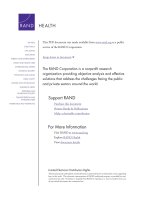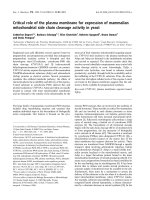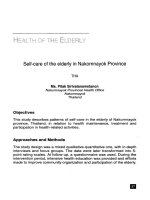2014 critical care of the stroke patient
Bạn đang xem bản rút gọn của tài liệu. Xem và tải ngay bản đầy đủ của tài liệu tại đây (25.6 MB, 623 trang )
Critical Care of the Stroke Patient
Downloaded from Cambridge Books Online by IP 216.195.11.197 on Thu Nov 05 23:12:13 GMT 2015.
/>Cambridge Books Online © Cambridge University Press, 2015
Downloaded from Cambridge Books Online by IP 216.195.11.197 on Thu Nov 05 23:12:13 GMT 2015.
/>Cambridge Books Online © Cambridge University Press, 2015
Critical Care of
the Stroke
Patient
Edited by
Stefan Schwab
Professor and Director, Department of Neurology, University
of Erlangen-Nuremberg, Erlangen, Germany
Daniel Hanley
Jeffrey and Harriet Legum Professor and Director, Division of Brain
Injury Outcomes, The Johns Hopkins Medical Institutions,
Baltimore, MD, USA
A. David Mendelow
Professor of Neurosurgery, Institute of Neuroscience,
University of Newcastle Upon Tyne,
Newcastle Upon Tyne, UK
Downloaded from Cambridge Books Online by IP 216.195.11.197 on Thu Nov 05 23:12:13 GMT 2015.
/>Cambridge Books Online © Cambridge University Press, 2015
University Printing House, Cambridge CB2 8BS, United Kingdom
Cambridge University Press is part of the University of Cambridge.
It furthers the University’s mission by disseminating knowledge in the pursuit of
education, learning and research at the highest international levels of excellence.
www.cambridge.org
Information on this title: www.cambridge.org/9780521762564
© Cambridge University Press
This publication is in copyright. Subject to statutory exception
and to the provisions of relevant collective licensing agreements,
no reproduction of any part may take place without the written
permission of Cambridge University Press.
First published 2014
Printing in the United Kingdom by TJ International Ltd. Padstow Cornwall
A catalogue record for this publication is available from the British Library
Library of Congress Cataloguing in Publication data
Critical care of the stroke patient / edited by Stefan Schwab, Daniel Hanley, A. David Mendelow.
Includes bibliographical references and index.
ISBN 978-0-521-76256-4 (hardback)
I. Schwab, S. (Stefan), editor of compilation. II. Hanley, D. F. (Daniel F.), editor of
compilation. III. Mendelow, A. David., editor of compilation.
[DNLM: 1. Stroke – therapy. 2. Critical Care – methods. WL 356]
ISBN 978-0-521-76256-4 Hardback
Cambridge University Press has no responsibility for the persistence or accuracy of
URLs for external or third-party internet websites referred to in this publication,
and does not guarantee that any content on such websites is, or will remain,
accurate or appropriate.
Every effort has been made in preparing this book to provide accurate and up-to-date information which is in accord
with accepted standards and practice at the time of publication. Although case histories are drawn from actual cases,
every effort has been made to disguise the identities of the individuals involved. Nevertheless, the authors, editors
and publishers can make no warranties that the information contained herein is totally free from error, not least
because clinical standards are constantly changing through research and regulation. The authors, editors and
publishers therefore disclaim all liability for direct or consequential damages resulting from the use of material
contained in this book. Readers are strongly advised to pay careful attention to information provided by the
manufacturer of any drugs or equipment that they plan to use.
Downloaded from Cambridge Books Online by IP 216.195.11.197 on Thu Nov 05 23:12:13 GMT 2015.
/>Cambridge Books Online © Cambridge University Press, 2015
Contents
List of contributors
Section 1. Monitoring Techniques
1
Intracranial pressure monitoring in
cerebrovascular disease
page viii
1
3
Anthony Frattalone and Wendy C. Ziai
2.
Cerebral blood flow
20
Rajat Dhar and Michael C. Diringer
3.
Brain tissue oxygen monitoring in
cerebrovascular diseases
37
Klaus Zweckberger and Karl L. Kiening
4.
Cerebral microdialysis in
cerebrovascular disease
44
Paul M. Vespa
5.
Ultrasound and other noninvasive
techniques used in monitoring
cerebrovascular disease
54
Gu¨nter Seidel
6.
Scales in the neurointensive care unit
66
Elise Rowan and Barbara A. Gregson
Section 2. Interventions
7.
Antiedema therapy in cerebrovascular
disease
79
81
Dimitre Staykov and Ju¨rgen Bardutzky
8.
Decompressive surgery in
cerebrovascular disease
90
Katayoun Vahedi and Franc¸ois Proust
v
Downloaded from Cambridge Books Online by IP 216.195.11.197 on Thu Nov 05 23:12:27 GMT 2015.
/>Cambridge Books Online © Cambridge University Press, 2015
vi
Contents
9a.
Neuroradiologic intervention in
cerebrovascular disease
19.
103
Neuroradiological interventions in
cerebrovascular disease: intracranial
revascularization
243
Sandeep Ankolekar and Philip Bath
Olav Jansen and Soenke Peters
9b.
Blood pressure management in acute
ischemic stroke
120
Section 4. Critical Care of Intracranial
Hemorrhage
255
Martin Radvany and Philippe Gailloud
10.
The use of hypothermia in
cerebrovascular disease
20.
129
11.
External ventricular drainage in
hemorrhagic stroke
21a. Management of acute hypertensive
response in the ICH patient
12.
Management of lumbar drains in
cerebrovascular disease
21b. Respiratory care of the ICH patient
13.
Intravenous and intra-arterial
thrombolysis for acute ischemic
stroke
158
21c. Nutrition in the ICH patient
Decompressive surgery and hypothermia
21d. Management of infections in the ICH
patient
167
21e. Management of cerebral edema in the
ICH patient
22a. Surgery for spontaneous intracerebral
hemorrhage
22b. Minimally invasive treatment options for
spontaneous intracerebral hemorrhage
16.
Critical care of basilar artery occlusion
194
22c. Image-guided endoscopic evacuation of
spontaneous intracerebral hemorrhage
335
Justin A. Dye, Daniel T. Nagasawa, Joshua
Perttu J. Lindsberg, Tiina Sairanen, and
R. Dusick, Winward Choy, Isaac Yang, Paul
Heinrich P. Mattle
17.
329
Andrew Losiniecki and Mario Zuccarello
190
H. Bart van der Worp and Stefan Schwab
320
A. David Mendelow, Barbara A. Gregson, and
Patrick Mitchell
M. Hemmen
Space-occupying hemispheric
infarction: clinical course, prediction,
and prognosis
315
Neeraj S. Naval and J. Ricardo Carhuapoma
169
179
306
Edgar Santos and Oliver W. Sakowitz
Rainer Kollmar, Patrick Lyden, and Thomas
15.
297
Dimitre Staykov and Ju¨rgen Bardutzky
Martin Ko¨hrmann and Stefan Schwab
14.
286
Omar Ayoub and Jeanne Teitelbaum
Dimitre Staykov and Hagen B. Huttner
Section 3. Critical Care of Ischemic
Stroke
274
Wondwossen G. Tekle and Adnan I. Qureshi
145
Mahua Dey, Jennifer Jaffe, and Issam A. Awad
257
Corina Epple and Thorsten Steiner
Dan Holmes, Sara Pitoni, Louise Sinclair, and
Peter J. D. Andrews
Management of intracranial hemorrhage:
early expansion and second bleeds
M. Vespa, and Neil A. Martin
Critical care of cerebellar stroke
206
23.
Tim Nowe and Eric Ju¨ttler
Intraventricular hemorrhage
348
Wendy C. Ziai and Daniel Hanley
18.
Rare specific causes of stroke
Alexander Beck, Philipp Go¨litz, and Peter
D. Schellinger
226
24.
Interventions for cerebellar hemorrhage
Jens Witsch and Eric Ju¨ttler
Downloaded from Cambridge Books Online by IP 216.195.11.197 on Thu Nov 05 23:12:27 GMT 2015.
/>Cambridge Books Online © Cambridge University Press, 2015
363
Contents
25.
Interventions for brainstem
hemorrhage
32.
378
33.
26.
Surgery for arteriovenous
malformations
385
Radiation therapy for arteriovenous
malformations
34.
387
394
Oliver Ganslandt, Sabine Semrau, and Reiner
28.
Management of cavernous angiomas of
the brain
Section 7. Critical Care of Cerebral
Venous Thrombosis
Medical interventions for subarachnoid
hemorrhage
Craniotomy for treatment of aneurysms
423
437
Arnd Do¨rfler
Ischemic brain damage in traumatic
brain injury (TBI): extradural, subdural,
and intracerebral hematomas and
cerebral contusions
501
515
447
517
A. David Mendelow
Index
Endovascular interventions for
subarachnoid hemorrhage
499
421
Patrick Mitchell
31.
Identification, differential diagnosis, and
therapy for cerebral venous thrombosis
Section 8. Vascular Disease
Syndromes Associated With Traumatic
Brain Injury
Joji B. Kuramatsu and Hagen B. Huttner
30.
490
400
36.
29.
Management of cardiopulmonary
dysfunction in subarachnoid hemorrhage
Jose´ M. Ferro and Patrı´cia Canha˜o
Mahua Dey and Issam A. Awad
Section 6. Critical Care of
Subarachnoid Hemorrhage
480
Jan-Oliver Neumann and Oliver W. Sakowitz
35.
Fietkau
Management of metabolic derangements
in subarachnoid hemorrhage
Kara L. Krajewski and Oliver W. Sakowitz
A. David Mendelow, Anil Gholkar, Raghu
Vindlacheruvu, and Patrick Mitchell
27.
464
Rajat Dhar and Michael C. Diringer
Berk Orakcioglu and Andreas W. Unterberg
Section 5. Critical Care of
Arteriovenous Malformations
Management of vasospasm in
subarachnoid hemorrhage
The color plate section can be found between
pages 252 and 253
Downloaded from Cambridge Books Online by IP 216.195.11.197 on Thu Nov 05 23:12:27 GMT 2015.
/>Cambridge Books Online © Cambridge University Press, 2015
538
vii
Contributors
Peter J. D. Andrews
Department of Anaesthesia, Critical Care & Pain
Medicine, University of Edinburgh, and Consultant,
Critical Care, Western General Hospital, Lothian
University Hospitals Division, Edinburgh, Scotland, UK
Sandeep Ankolekar
Division of Stroke, University of Nottingham,
Nottingham, UK
Issam A. Awad
Section of Neurosurgery and Neurovascular Surgery
Program, Division of Biological Sciences and the
Pritzker School of Medicine, The University of Chicago,
Chicago, IL, USA
Omar Ayoub
Assistant Professor of Neurology, Stroke, and
Neurocritical Care, Jeddah, Saudi Arabia
Philip Bath
Division of Stroke Medicine, University of Nottingham,
Nottingham, UK
Ju¨rgen Bardutzky
Department of Neurology, University of Freiburg,
Freiburg, Germany
Alexander Beck
Department of Neurology, Friedrich-AlexanderUniversity of Erlangen-Nuremberg, Erlangen, Germany
viii
Downloaded from Cambridge Books Online by IP 216.195.11.197 on Thu Nov 05 23:12:41 GMT 2015.
/>Cambridge Books Online © Cambridge University Press, 2015
List of contributors
Patrı´cia Canha˜o
Department of Neurosciences (Neurology), Hospital
de Santa Maria, University of Lisbon, Lisboa,
Portugal
J. Ricardo Carhuapoma
Department of Neurology, Neurosurgery and
Anesthesiology & Critical Care Medicine, The Johns
Hopkins Hospital, Baltimore, MD, USA
Winward Choy
Department of Neurosurgery, David Geffen School of
Medicine at UCLA, Los Angeles, CA, USA
Mahua Dey
Section of Neurosurgery and Neurovascular Surgery
Program, Division of Biological Sciences and the
Pritzker School of Medicine, The University of Chicago,
Chicago, IL, USA
Rajat Dhar
Department of Neurology, Division of Neurocritical
Care, Washington University School of Medicine, Saint
Louis, MO, USA
Jose´ M. Ferro
Department of Neurosciences (Neurology), Hospital de
Santa Maria, University of Lisbon, Lisboa, Portugal
Reiner Fietkau
Department of Neurosurgery and Radiation Therapy,
University of Erlangen-Nuremberg, Erlangen, Germany
Anthony Frattalone
Department of Neurology, Division of Neurocritical
Care, The Johns Hopkins University School of
Medicine, Baltimore, MD, USA
Philippe Gailloud
Department of Interventional Neuroradiology, The
Johns Hopkins University School of Medicine,
Baltimore, MD, USA
Oliver Ganslandt
Department of Neurosurgery and Radiation Therapy,
University of Erlangen-Nuremberg, Erlangen, Germany
Anil Gholkar
The Newcastle Upon Tyne Hospitals NHS Foundation
Trust, Newcastle Upon Tyne, UK
Michael C. Diringer
Department of Neurology, Division of Neurocritical
Care, Washington University School of Medicine, Saint
Louis, MO, USA
Philipp Go¨litz
Department of Neuroradiology, University of
Erlangen-Nuremberg, Erlangen, Germany
Arnd Do¨rfler
Department of Neuroradiology, University of
Erlangen-Nuremberg, Erlangen, Germany
Barbara A. Gregson
Institute of Neuroscience, University of Newcastle
Upon Tyne, UK
Joshua R. Dusick
Department of Neurosurgery, David Geffen School of
Medicine at UCLA, Los Angeles, CA, USA
Daniel Hanley
Division of Brain Injury Outcomes, The Johns
Hopkins Medical Institutions, Baltimore, MD, USA
Justin A. Dye
Department of Neurosurgery, David Geffen School of
Medicine at UCLA, Los Angeles, CA, USA
Thomas M. Hemmen
Department of Neurosciences, University of California
San Diego School of Medicine, San Diego, CA, USA
Corina Epple
Department of Neurology, Klinikum Frankfurt Höchst,
Frankfurt, Germany
Dan Holmes
Department of Anaesthesia, Critical Care & Pain
Medicine, University of Edinburgh, and Consultant,
Downloaded from Cambridge Books Online by IP 216.195.11.197 on Thu Nov 05 23:12:41 GMT 2015.
/>Cambridge Books Online © Cambridge University Press, 2015
ix
x
List of contributors
Critical Care, Western General Hospital Lothian
University Hospitals Division, Edinburgh,
Scotland, UK
Hagen B. Huttner
Department of Neurology, University of
Erlangen-Nuremberg, Erlangen, Germany
Jennifer Jaffe
Section of Neurosurgery and Neurovascular
Surgery Program, Division of Biological
Sciences and the Pritzker School of Medicine,
The University of Chicago, Chicago, IL, USA
Olav Jansen
Institute of Neuroradiology, University of Kiel, Kiel,
Germany
Eric Ju¨ttler
Center for Stroke Research Berlin (CSB), Charité
University Medicine Berlin, Berlin, Germany
Karl L. Kiening
Department of Neurosurgery,
Universitätsklinikum Heidelberg, Heidelberg,
Germany
Martin Ko¨hrmann
Department of Neurology, University Hospital
Erlangen, Erlangen, Germany
Rainer Kollmar
Clinic for Neurology and Neurogeriatrics, Darmstadt,
Germany
Kara L. Krajewski
Department of Neurosurgery, University Hospital
Heidelberg, Germany
Joji B. Kuramatsu
Department of Neurology, University of
Erlangen-Nuremberg, Erlangen, Germany
Perttu J. Lindsberg
Department of Neurology, Helsinki University
Central Hospital, and Molecular Neurology
Research Programs Unit, Biomedicum Helsinki,
and Department of Clinical Neurosciences,
University of Helsinki, Helsinki,
Finland
Andrew Losiniecki
Department of Neurosurgery, University of Cincinnati
Neuroscience Institute and University of Cincinnati
College of Medicine, Cincinnati, OH, USA
Patrick Lyden
Department of Neurosciences, University of
California San Diego School of Medicine, San Diego,
CA, USA
Neil A. Martin
Department of Neurosurgery, David Geffen School
of Medicine at UCLA, Los Angeles, CA, USA
Heinrich P. Mattle
Department of Neurology, University of Bern,
Inselspitel, Bern, Switzerland
A. David Mendelow
Department of Neurosurgery, Institute of
Neuroscience, University of Newcastle Upon Tyne,
Newcastle Upon Tyne, UK
Patrick Mitchell
Department of Neurosurgery, Royal Victoria Infirmary,
Newcastle Upon Tyne, UK
Daniel T. Nagasawa
Department of Neurosurgery, David Geffen School of
Medicine at UCLA, Los Angeles, CA, USA
Neeraj S. Naval
Department of Neurology, Neurosurgery,
Anesthesiology and Critical Care Medicine, The Johns
Hopkins Hospital, Baltimore, MD, USA
Downloaded from Cambridge Books Online by IP 216.195.11.197 on Thu Nov 05 23:12:41 GMT 2015.
/>Cambridge Books Online © Cambridge University Press, 2015
List of contributors
Jan-Oliver Neumann
Department of Neurosurgery, University Hospital
Heidelberg, Germany
Oliver W. Sakowitz
Department of Neurosurgery, University Hospital
Heidelberg, Germany
Tim Nowe
Center for Stroke Research Berlin (CSB), Charité
University Medicine Berlin, Berlin, Germany
Edgar Santos
Department of Neurosurgery, University Hospital
Heidelberg, Germany
Berk Orakcioglu
Department of Neurosurgery, University of Heidelberg,
Heidelberg, Germany
Peter D. Schellinger
Department of Neurology, Ruprechy-Karls-University,
Heidelberg, Germany
Soenke Peters
Institute of Neuroradiology, University of Kiel, Kiel,
Germany
Stefan Schwab
Department of Neurology, University of
Erlangen-Nuremberg, Erlangen, Germany
Sara Pitoni
Department of Anesthesiology and Intensive
Care Unit, Policlinico Universitario ‘Agostino Gemelli’,
Università Cattolica del Sacro Cuore of Rome,
Rome, Italy
Gu¨nter Seidel
Department of Neurology, Medical University at
Lübeck, Lübeck, Germany
Franc¸ois Proust
Neurosurgery Department, Centre Hospitalier
Universitaire de Rouen, Rouen, France
Adnan I. Qureshi
Zeenat Qureshi Stroke Research Center, University
of Minnesota, MN, USA
Martin Radvany
Department of Interventional Neuroradiology, The
Johns Hopkins University School of Medicine,
Baltimore, MD, USA
Elise Rowan
Institute of Neurosciences, University of Newcastle
Upon Tyne, UK
Tiina Sairanen
Department of Neurology, Helsinki University Central
Hospital, Helsinki, Finland
Sabine Semrau
Department of Neurosurgery and Radiation
Therapy, University of Erlangen-Nuremberg, Erlangen,
Germany
Louise Sinclair
Department of Anaesthesia, Critical Care & Pain
Medicine, University of Edinburgh, and
Consultant, Critical Care, Western General Hospital
Lothian University Hospitals Division, Edinburgh,
Scotland, UK
Dimitre Staykov
Department of Neurology, University of
Erlangen-Nuremberg, Erlangen, Germany
Thorsten Steiner
Department of Neurology, Klinikum Frankfurt
Höchst, Frankfurt, and Department of Neurology,
Heidelberg University Hospital,
Heidelberg, Germany
Downloaded from Cambridge Books Online by IP 216.195.11.197 on Thu Nov 05 23:12:41 GMT 2015.
/>Cambridge Books Online © Cambridge University Press, 2015
xi
xii
List of contributors
Jeanne Teitelbaum
Department of Neurology and Neurosurgery, Montreal
Neurological Institute and MUHC, Montreal, Quebec,
Canada
Wondwossen G. Tekle
Zeenat Qureshi Stroke Research Center, University of
Minnesota, MN, USA
Andreas W. Unterberg
Department of Neurology, University of Heidelberg,
Heidelberg, Germany
Katayoun Vahedi
Neurology Department, Lariboisière Hospital,
Assistance Publique-Hôpitaux de Paris, Paris,
Consultant Neurologist, Hôpital Privé d’Antony,
Antony, France
H. Bart van der Worp
Department of Neurology and Neurosurgery, Brian
Center Rudolf Magnus, University Medical Center
Utrecht, Utrecht, The Netherlands
Paul M. Vespa
Department of Neurology and Neurosurgery, David
Geffen School of Medicine at UCLA, Los Angeles, CA, USA
Raghu Vindlacheruvu
Queen’s Hospital, Romford, Essex, UK
Jens Witsch
Department of Neurology, Charité University Medicine
Berlin, Berlin, Germany
Isaac Yang
Department of Neurosurgery, David Geffen School of
Medicine at UCLA, Los Angeles, CA, USA
Wendy C. Ziai
Department of Neurology, Division of Neurocritical
Care, The Johns Hopkins University School of
Medicine, Baltimore, MD, USA
Mario Zuccarello
Department of Neurosurgery, University of Cincinnati
Neuroscience Institute and University of Cincinnati
College of Medicine, and Mayfield Clinic, Cincinnati,
OH, USA
Klaus Zweckberger
Department of Neurosurgery, Universitätsklinikum
Heidelberg, Heidelberg, Germany
Downloaded from Cambridge Books Online by IP 216.195.11.197 on Thu Nov 05 23:12:41 GMT 2015.
/>Cambridge Books Online © Cambridge University Press, 2015
SECTION 1
Monitoring Techniques
Downloaded from Cambridge Books Online by IP 216.195.11.197 on Thu Nov 05 23:13:16 GMT 2015.
/>Cambridge Books Online © Cambridge University Press, 2015
Downloaded from Cambridge Books Online by IP 216.195.11.197 on Thu Nov 05 23:13:16 GMT 2015.
/>Cambridge Books Online © Cambridge University Press, 2015
Cambridge Books Online
/>
Critical Care of the Stroke Patient
Edited by Stefan Schwab, Daniel Hanley, A. David Mendelow
Book DOI: />Online ISBN: 9780511659096
Hardback ISBN: 9780521762564
Chapter
1 - Intracranial pressure monitoring in cerebrovascular disease pp. 319
Chapter DOI: />Cambridge University Press
1
Intracranial pressure monitoring
in cerebrovascular disease
Anthony Frattalone and Wendy C. Ziai
Introduction to intracranial pressure
monitoring
Intracranial pressure monitoring remains a central tenet
of neurocritical care monitoring and has the potential
to improve outcome (1–3). While the importance of
monitoring and controlling intracranial pressure (ICP)
and cerebral perfusion pressure (CPP) in traumatic
brain injury is fairly well understood, its significance in
acute cerebrovascular disease and the modulatory effect
of therapies remain largely unexplored. This review helps
to clarify basic principles and evidence for ICP monitoring and ICP-based treatment and applies these principles
to the management of acute cerebrovascular disease.
Principles of intracranial dynamics
The intracranial contents (and average volumes in
the adult male) contributing to the ICP are the brain
(1300 mL), blood (110 mL) and cerebrospinal fluid
(CSF) (65 mL) (4). In normal subjects, average ICP has
been reported to be approximately 10 mmHg (5).
According to the Monro-Kellie doctrine, because the
intracranial contents are encased in a rigid skull and
the components are relatively inelastic, change in the
volume of one component must be compensated for by
reduction in the volume of another component of the
system or ICP will increase. Without this compensation,
increased ICP may result in brain herniation by direct
compression or ischemia/infarction by compromising
cerebral blood flow (CBF). While arguably a simplification
of the complex pathophysiology involved, the MonroKellie doctrine remains a helpful principle in understanding derangements in intracranial pressure.
The brain is considered a viscoelastic solid, comprising approximately 80% water, of which the extracellular compartment represents approximately 15%
and the intracellular compartment the other 85% (6).
Neither of these components has significant compressibility and, as a result, the brain can be displaced
minimally, although it can expand under certain
circumstances.
The CSF makes up about 10% of the intracranial
volume and is produced predominantly by the choroid
plexus, with a small amount produced as interstitial
fluid from brain capillaries (7). Production is approximately 500 cc/day and is not significantly reduced by
rising ICP (8). Resorption of CSF into cerebral venous
sinuses occurs over a pressure gradient at the arachnoid villi by a poorly understood mechanism (9). In
normal subjects, resorption increases linearly with
ICP above about 7 mmHg (10). However, it is hypothesized that in cases of increased venous pressure, such
as cerebral venous thrombosis, that resorption is
impaired and can lead to elevated ICP (11).
As long as obstructive hydrocephalus is not present,
displacement of CSF into the lumbar subarachnoid
space through the foramen magnum is the initial
compensatory mechanism after addition of excessive
Critical Care of the Stroke Patient, ed. Stefan Schwab, Daniel Hanley, and A. David Mendelow. Published by Cambridge University Press.
© Cambridge University Press 2014.
3
Downloaded from Cambridge Books Online by IP 216.195.11.197 on Thu Nov 05 23:13:29 GMT 2015.
/>Cambridge Books Online © Cambridge University Press, 2015
Chapter 1: Intracranial pressure monitoring
volume to the system (12). In reality, this compensation
may often be insufficient in cases of low distensibility of
the spinal compartment and is dependent on a normal
spinal subarachnoid space and open foramen magnum.
Head-up positioning to maximize this compensation and
allow CSF displacement, are essential. Compensation is
compromised by supine/Trendellenberg position,
tonsillar herniation or pathology causing spinal epidural block (13). Another potential adaptive mechanism may be a decrease in CSF volume caused by
increased absorption due to lowering of outflow resistance at the arachnoid villi (5).
Another potential compensatory mechanism for
increased ICP is shunting of cerebral and dural venous
sinus blood out of the cranial compartment into the
central venous pool. While resistance to venous drainage
by compression of the neck veins is a well-established
cause of increased ICP, shift of venous blood volume in
response to ICP elevation has less direct evidence (11).
Nevertheless, increasing intrathoracic pressure with
positive pressure ventilation and high intra-abdominal
pressure have been implicated in causing ICP elevation
via reduced cerebral venous drainage (14).
Once the limits of compensatory mechanisms for
displacement of CSF and blood are exceeded, the slope
of the intracranial pressure–volume curve increases
substantially, representing decreased compliance
80
Intracranial pressure (mmHg)
4
60
40
20
0
Intracranial volume
Fig. 1.1 The effect of increasing intracranial volume on
intracranial pressure.
(Fig. 1.1). Intracranial compliance (ΔV/ΔP), decreases
quickly (exponential part of the curve) followed by the
vertical portion where increased ICP may be irreversible
and herniation occurs. Thus, in states of poor compliance, a seemingly insignificant increase in intracranial
volume can result in a dramatic increase in ICP. Finally,
when ICP increases beyond mean arterial blood pressure (MAP), blood is unable to enter the skull, leading to
global ischemia and eventual infarction.
The intracranial blood volume, about 10% of the
volume within the skull, is approximately 2/3 venous,
1/3 arterial. Arterial blood flow is regulated primarily
by change in caliber of arterioles, which adjusts in
response to systemic arterial pressure, partial pressure
of oxygen (pO2), and partial pressure of carbon dioxide
(pCO2). Carbon dioxide tension in arteriolar blood
appears to be the most significant determinant of vessel
diameter. Over the range of PCO2 usually encountered
clinically, CBV decreases as PCO2 level decreases. Even
though CBF (and therefore CBV) remain fairly static at
physiologic levels of PO2, CBF increases rapidly if
PO2 dips below 50 mmHg. Thus, hypoxia and hypercarbia may significantly increase ICP through increases
in CBV. Hypocarbia, on the other hand, significantly
decreases CBV and hence ICP. Overall, changes in vessel
caliber at the arteriolar level allow significant alteration
in total intravascular blood volume (from 15 to 70 mL)
and can thus compensate for relatively large increases in
intracranial volume (5). These are the principles that
inform the practice of hyperventilation to lower ICP.
Cerebral autoregulation refers to the ability of the
system to maintain constant CBV throughout a range
of mean arterial blood pressure (MAP) from approximately 50–150 mmHg (Fig. 1.2). In normal subjects who
experience a decrease in CPP, CBV remains normal
due to compensatory arteriolar vasodilation. However,
when the normal compensatory system is breeched
such as with global ischemia (MAP below range) or
malignant hypertension (MAP above range), the CBF
becomes dependent on MAP. In both cases, CBF varies
linearly with MAP. The main mechanism of cerebral
autoregulation is vasodilatation and constriction guided
by CPP induced changes in cerebral blood flow (CBF =
CPP/cerebrovascular resistance). The cerebral blood
vessels respond little to changes in arterial PO2 above
Downloaded from Cambridge Books Online by IP 216.195.11.197 on Thu Nov 05 23:13:29 GMT 2015.
/>Cambridge Books Online © Cambridge University Press, 2015
Chapter 1: Intracranial pressure monitoring
50
20
20
80
100
140
180
MAP (mmHg)
Intracranial pressure
CBF (ml/min/100 g)
CBF autoregulation curve
80
P1
P2 P
3
Compliant Brain
P1
P2
P3
Fig. 1.2 Cerebral blood flow autoregulation curve. From:
Gardner CJ, Lee K. CNS Spectr. 12(1): 2007.
Non-compliant Brain
Time
Fig. 1.3 Relationship between ICP and brain compliance
50 mmHg. Below this level, in conditions such as neurogenic pulmonary edema, status epilepticus, or pulmonary embolism, CBF increases significantly, almost
doubling at PO2 30 mmHg (5). This point highlights
the importance of avoiding hypoxemia and subsequent
cerebral arteriolar dilation in patients with elevated
ICP. Additionally, vasodilatation in response to elevated
PCO2 is maximized at levels above 80 mmHg (doubling
of baseline). As expected, vasoconstriction occurs with
mild lowering of the PCO2 below normal; however,
extremely low PCO2 (<20 mmHg) levels may cause a
paradoxical increase in ICP since extreme vasoconstriction can cause tissue ischemia, triggering vasodilation
(5). Elevation in ICP does not change autoregulatory
responses; rather an autonomic response increases
MAP with reflex bradycardia as part of the Cushing
response. Acute intracranial hypertension shifts the
lower limit of autoregulation towards lower CPP levels,
which may be due to dilatation of small resistance vessels (15). Longstanding systemic hypertension shifts
the entire curve right by 20–30 mmHg, a change that is
protective against hypertensive encephalopathy when
large increases in blood pressure occur.
Autoregulation may be impaired regionally in conditions such as stroke or more globally in diffuse anoxic
injury or traumatic brain injury (TBI), which can result
in an abnormal linear relationship between MAP and
CBF. The many possible types of cerebral insults result
in highly variable levels and types of impairment of
autoregulation from case to case.
Cerebral perfusion pressure (CPP) is a key therapeutic
target to prevent potentially fatal cerebral hypoperfusion.
Defined as MAP – ICP, the CPP is dependent on both ICP
and systemic blood pressure.
The ICP at equilibrium is below 10 mmHg with no
pressure gradient between brain regions. The normal
ICP waveform has three peaks: the percussion wave
(P1), due to choroid plexus pulsation, the tidal wave
(P2), a manifestation of compliance, and the dicrotic
wave (P3), due to pulsations of the major cerebral
arteries. When ICP increases and the slope of the
pressure–volume curve rapidly increases, this is a reflection of decreased compliance. In this setting, P2 increases
in magnitude and P1 is blunted, merging into P2 as
compliance declines (Fig. 1.3) (16). Therefore, by examining the ICP waveform the physician can estimate the
amount of compliance remaining in the system and
adjust therapy to improve these parameters.
Failure of brain compliance may be accompanied by
plateau, Lundberg A waves, or sudden increases in ICP
up to 50–80 mmHg lasting 5–20 mins (17). Plateau
waves are indicative of cerebral ischemia and may be
triggered by usual ICU procedures such as tracheal
suctioning, lowering the head of the bed, and routine
hygiene (Fig. 1.4).
Neuromonitoring
Several studies have shown that estimation of ICP and
herniation risk by clinical grounds alone is inaccurate,
arguing for the need for objective ICP monitoring devices (18). Much of the data in support of intensive
Downloaded from Cambridge Books Online by IP 216.195.11.197 on Thu Nov 05 23:13:29 GMT 2015.
/>Cambridge Books Online © Cambridge University Press, 2015
5
Chapter 1: Intracranial pressure monitoring
Intracranial pressure (mmHg)
6
40
30
20
10
0
10
20
30
40
50
60
Time (minutes)
Fig 1.4 Lundberg A waves
ICP monitoring has its origin in the TBI literature.
Although a randomized controlled trial of ICP monitoring with and without treatment is unlikely to ever be
done, ICP monitoring is now considered standard management for patients with severe TBI and is associated
with improved outcomes (18). It is clear that after brain
injury of any type that ICP is not static, but instead
reflective of a dynamic system with many inputs including CPP, intracranial volume changes, and the effectiveness of adaptive mechanisms. As in TBI, acute
cerebrovascular events also follow stages of evolution
including mass expansion, vascular changes and edema
formation, which occur over several days. Without direct
ICP measurement over this time period, there is no way
to calculate CPP and thus no way to understand any
given patient’s cerebral blood flow and adaptive limitations. Finally, since there is considerable risk involved
with prophylactic treatment of elevated ICP (hyperosmotic therapy, hyperventilation, hypothermia, surgery),
it is imperative that ICP estimations be accurate to avoid
unnecessary harm to patients.
There is evidence to support the notion that lowering
ICP early is superior to an approach that relies on
imaging or clinical deterioration before initiation of
treatment (19). Often elevations in ICP can be an early
indicator of worsening pathology, which could warrant
urgent imaging and lead to timely medical or surgical
treatment (18). Moreover, even though imaging assessment is essential, a significant percentage of TBI patients
in coma with normal initial CT scans will later develop
elevated ICP (20).
While elevated ICP can often be detected on clinical
exam in conjunction with imaging and fundoscopic
exam, none of these techniques provides an objective
measure that can be followed frequently. Studies suggest that optic disc edema often takes at least one day
to develop on fundoscopic exam, which is an unacceptable delay (21). Studies to evaluate CT scanning as a
screening tool suggest that compression of the third
ventricle and basal cisterns are correlated with abnormally high ICPs (22), but this method provides only a
‘snap shot’ in time and thus does not allow continuous
monitoring. Results of studies on transcranial Doppler
ultrasonography (TCD), which evaluates the basal cerebral arterial blood flow, has also been shown to correlate with high ICP in the context of changes in CPP but
is not considered a sensitive screening or monitoring
tool with regards to ICP (23). Some investigators have
shown that the TCD pulsatility index correlates with
ICP (24) while other more recent studies question the
Downloaded from Cambridge Books Online by IP 216.195.11.197 on Thu Nov 05 23:13:29 GMT 2015.
/>Cambridge Books Online © Cambridge University Press, 2015
Chapter 1: Intracranial pressure monitoring
Death
Poor Outcome (mRS of 4 or 5)
100%
86%
87%
Percent of Subjects
72%
56%
50%
22%
9%
EVD + Thrombolysis
(n = 55)
EVD Alone
(n = 150)
Conservative
Treatment (n = 130)
EVD + Thrombolysis
(n = 55)
EVD Alone
(n = 150)
Conservative
Treatment (n = 130)
0%
*Nieukamp rates are ascertained at variable times
Fig 1.5 The effect of EVD on mortality as compared to traditional treatments.
accuracy of this measure (25). Interestingly, there is
some promising preliminary evidence supporting the
use of ultrasound of the optic nerve sheath as a screening and monitoring tool for elevated ICP, but this is not
routinely available in most centers at this time (26).
With this technique, ultrasound measurement of the
optic nerve sheath is done rapidly at the bedside and is
currently being validated as a diagnostic tool. Several
studies have found the threshold optic nerve sheath
diameter (ONSD) which provides the best accuracy
for the prediction of intracranial hypertension (ICP
>20 mmHg) is 5.7–6.0 mm, and that ONSD values
above this threshold should alert the clinician to the
presence of raised ICP (Fig. 1.5) (26). Unfortunately,
even in the hands of a skilled physician, these
noninvasive screening techniques currently determine
only whether high ICP is present but most likely are not
sensitive enough to gauge subtle changes in response to
therapy.
In deciding whom to monitor ICP with invasive techniques, many centers use GCS <9 as a cutoff, with the
assumption being that patients who are able to follow
commands are likely to not have devastatingly high ICP,
and the neurologic exam itself substitutes for the monitor.
Still, there may be circumstances where an invasive ICP
monitor is indicated in a patient with a preserved level of
consciousness when the imaging suggests high likelihood
of pending deterioration, when a change in the patient’s
care is expected to increase ICP further (such as high
positive end-expiratory pressure (PEEP) or when
Downloaded from Cambridge Books Online by IP 216.195.11.197 on Thu Nov 05 23:13:29 GMT 2015.
/>Cambridge Books Online © Cambridge University Press, 2015
7
8
Chapter 1: Intracranial pressure monitoring
sedation is needed and therefore the ability to follow the
patient’s neurologic exam will be impaired.
Duration of ICP monitoring is variable depending on
the patient and the institution, but decision to remove
the monitor is usually based on neurologic stabilization
or normalization of ICP. Extended monitoring is unadvisable except in rare cases due to increased infectious
risk over time. On the contrary, when deciding to
remove the monitor, caution must be taken to avoid
missing delayed increases in ICP, which can occur after
a period of pseudo-normalization. For example, a secondary rise in ICP after 3–10 days has been observed in
a significant percentage of TBI patients (3).
Types of monitors
All currently commercially available ICP monitors are
invasive and necessitate the creation of a dural breach.
While sometimes used to estimate ICP, measurements
from lumbar cistern catheters (either opening pressure
or drain catheter) are more dependent on patient
positioning and do not reflect pressure gradients in
obstructive hydrocephalus. A recent study suggests that
lumbar drain pressure measurements correlate well
with EVD measurements in acute post-hemorrhagic
communicating hydrocephalus (27). There are several
other options available for measuring ICP through the
skull, allowing a more direct evaluation. The gold standard remains the intraventricular catheter, commonly
referred to as an external ventricular drain (EVD) (28).
An EVD is a catheter placed in the ventricle to allow
transduced pressure readings as well as serving as a
conduit for therapeutic drainage of CSF. Since it can be
recalibrated it is felt to be more accurate and less prone
to drift over time (21). However, intraventricular monitoring may not reflect compartmental increases in pressure that do not immediately result in transmission of
pressure to the lateral or third ventricles, such as with
the case of infratentorial masses or focal herniations.
Intraventricular catheters may also be difficult to place
in the context of traumatic brain injury or diffuse edema,
which often causes the ventricles to shrink down to
slit-like proportions. Other problems encountered with
the use of EVDs include system damping from
positioning of the catheter against the ventricular wall
and catheter occlusion with blood or tissue clot.
Intraparenchymal monitors are extremely useful in
certain cases, although they may be more prone to drift
over time (21). These monitors are usually placed via a
burr hole in the brain parenchyma and use a fiberoptic
transducer at the catheter tip. CSF cannot be drained
using this type of monitor. Some studies have shown
that the Camino catheters correlate very well with IVCs,
making this type of monitor preferred in some centers
due to its ease of insertion, especially in the headinjured patient with small ventricles.
Subdural and subarachnoid screws are fluid-filled
bolts which are screwed into a burr hole until flush
with the incised dura, allowing CSF pressure to be transduced. Although they have advantages of ease of insertion and low complication rates, they are felt by many
experts to be less accurate and can provide falsely low
(dampened) readings with high ICP if tissue obstructs
the lumen (29).
Complications of invasive ICP monitoring
Complications of ICP monitoring include hemorrhage,
infection, and parenchymal brain injury. Catheterrelated hemorrhages (intraparenchymal, intraventricular, subdural or along the catheter tract) occur in 1–33%
of patients, many of which are small and asymptomatic
(30). Risk for hemorrhage seems to be the highest with
EVDs (31). Hemorrhage most often occurs at the time
of catheter placement but may also be a delayed phenomenon. Malpositioning of EVDs is also not infrequent, but is clearly dependent on definition (32).
While infection is a bona fide concern due to associated morbidity, clinically insignificant catheter colonization is far more common. Neither fever, CSF pleocytosis,
nor peripheral leukocytosis carry a high predictive
value for infections (33). The high occurrence of these
laboratory abnormalities in patients with acute brain
injuries and effects of catheter placement probably
explain these observations. Several series evaluating
infection risk with IVCs have shown that risk is highest
after five days and this complication is rare if used for
three days or less (21). Level III evidence exists against
Downloaded from Cambridge Books Online by IP 216.195.11.197 on Thu Nov 05 23:13:29 GMT 2015.
/>Cambridge Books Online © Cambridge University Press, 2015
Chapter 1: Intracranial pressure monitoring
routine antibiotic prophylaxis or IVC exchange, especially with newer antibiotic-coated catheters (34).
Other risk factors for IVC-related infection include
ICH, SAH or IVH, ICP>20, system irrigation, leakage,
open skull fractures, and systemic infection. Sterile
insertion of the IVC in the ICU (rather than the operating
room) has not been associated with an increased risk
of infection and neither has previous IVC, drainage of
CSF, or steroids)(35–37).
Intracranial pressure vs. cerebral perfusion
pressure
The TBI literature is engaged with a controversy over
the importance of CPP or ICP as targets for ICU management. The occurrence of brain ischemia, reduced
CPP and jugular venous desaturation in the context
of elevated ICP have been well described and brain
ischemia after TBI is treated almost as a ‘dogma’ (38) .
However, since severe TBI is so often accompanied
by diffuse axonal injury, it may be difficult to extrapolate data from the TBI population to patients with primary cerebrovascular pathology. The Rosner protocol
emphasizes preservation of cerebral blood flow to
prevent cerebral ischemia (39). Although unproven
by a randomized controlled study, it is argued that
treatment directed at maintaining CPP > 70 mmHg is
superior to traditional techniques focused on ICP
management.
In Rosner’s study, methods used included vascular
volume expansion, cerebrospinal fluid drainage via
ventriculostomy, systemic vasopressors (phenylephrine or norepinephrine), and mannitol. Barbiturates,
hyperventilation, and hypothermia were specifically
not used. Comparisons of outcome classification across
GCS categories (survival vs. death, favorable vs. nonfavorable) with other reported series were significantly
better in Rosner’s series. Mechanistically, decreased
CPP due to either increased ICP or low blood pressure
results in vasodilatation. This vasodilation increases
cerebral blood volume (CBV) and exacerbates ICP
and thus further reduces CPP, which can only be
improved by increasing blood pressure. The Achilles
heel of this approach is that permitting a high CPP can
worsen cerebral edema especially where the blood
brain barrier is not intact.
The relative influence of ICP and CPP on outcome
was assessed in patients who had neurological deterioration from the international, multicenter, randomized, double-blind trial of the N-methyl-D-aspartate
antagonist Selfotel in patients with TBI (40). The most
powerful predictor of neurological worsening was
intracranial hypertension (ICP > or = 20 mmHg) either
initially or during neurological deterioration. There
was no correlation with CPP as long as CPP was greater
than 60 mmHg. It has therefore become more common
that treatment protocols for the management of severe
head injury emphasize immediate reduction of elevated ICP to less than 20 mmHg. A CPP greater than
60 mmHg appears to have little influence on the outcome of patients with severe head injury. These basic
tenets highlight the relative importance of ICP and CPP
in the TBI population.
Intracranial pressure and ischemic stroke
Stroke has been associated with increased ICP usually in
the context of major hemispheric infarction leading to
cerebral edema with risk for herniation and death. Most
often this phenomenon is observed after a malignant
middle cerebral artery infarction, which carries 70–80%
mortality if treated conservatively. Furthermore, uncal
herniation complicates malignant MCA infarction in
78% of cases (41).
The value of ICP monitoring in large middle cerebral
artery infarction is debated in the literature, but infrequently put into practice. Space-occupying cerebral
edema can result in elevated ICP and cerebral herniation. In fact, this was the primary cause of mortality
within the first week in ECASS, the European
Cooperative Acute Stroke Study (42). In a study of 48
patients with clinical signs of increased ICP due to large
hemispheric infarction, epidural ICP sensors were
inserted ipsilateral to the primary brain injury and also
contralaterally in seven patients (43). ICP was normal at
the time of insertion in 74%, 20–25 mmHg in 37 patients,
25–35 mmHg in eight patients, and > 35 mmHg in three
patients who all died. ICP increased in all patients
Downloaded from Cambridge Books Online by IP 216.195.11.197 on Thu Nov 05 23:13:29 GMT 2015.
/>Cambridge Books Online © Cambridge University Press, 2015
9
10
Chapter 1: Intracranial pressure monitoring
during the first two days after monitor insertion and was
significantly higher in patients who died compared with
survivors (mean 42 vs. 28 mmHg). ICP was higher ipsilateral to the stroke in patients with bilateral monitors
with a difference up to 15 mmHg. All patients with any
ICP > 35 mmHg during monitoring died. However,
although high ICP correlated with clinical outcome, the
initial ICP did not predict outcome and clinical herniation signs preceded critical ICP elevation, casting some
doubt on the ability to utilize ICP values to affect clinical
outcomes in this context. Moreover, CT findings such as
severe midline shift did not correlate with ICP values.
Medical management of elevated ICP was initially effective, but failed beyond the first few doses of osmotic
therapy. The authors concluded that ICP monitoring
did not positively influence outcomes, but may serve as
a predictor during therapy. These results are supported
by an earlier study by Frank of 19 patients with large
hemispheric infarction who underwent ICP monitoring
prior to neurologic deterioration (44). In this study, ICP >
18 mmHg within the first 12 hours of clinical progression
to stupor predicted 83% mortality despite maximal medical therapy. However, elevated ICP was not commonly
associated with initial neurologic deterioration secondary to mass effect. Contrary to the prior study, patients
with initial ICP elevation were significantly younger than
those without.
Since intra-arterial recombinant tissue plasminogen
activator is not an appropriate treatment for malignant
MCA infarction due to high rates of brain hemorrhage,
many experts have recommended decompressive craniectomy (DC). The rationale for decompressive surgery is to reduce ICP and optimize CBF in addition to
minimizing further infarction from cerebral edema. In a
study of 42 patients undergoing DC for malignant MCA
infarction, ICP was monitored with an intraparenchymal fiberoptic sensor during and post-operatively. An
anterior temporal lobectomy was performed if ICP
increased > 30 mmHg, which occurred in 13/42 (31%)
of patients, including three patients who underwent
anterior lobectomy two to three days after initial decompression and regained consciousness promptly after
operation (45). Two-thirds of such patients survived
compared with no survival in patients who developed
ICP > 30 mmHg, but did not undergo further anterior
temporal lobectomy.
Numerous reports suggest that DC is an effective
means of ICP control at least in the TBI population (46–
51). This operation includes a wide range of surgical
procedures, all of which involve removal of large parts
of the skull with or without dural augmentation, resection
of brain tissue and occasional sectioning of the tentorium
or falx. A pooled analysis of decompressive craniectomy
performed less than 48 hours after ictus for malignant
MCA infarction has also been shown to enhance survival
in three European trials, although high rates of disability
and depression were still observed (52). Physiologic findings after DC include cerebral blood flow (CBF) augmentation that is likely a result of decrease in CPP, but no
significant improvement in CMRO2 levels (53). In a comparison of 36 TBI patients who received DC and 86
patients who did not, CMRO2 levels were significantly
lower in the operated group, even after adjustment for
injury severity, and were strongly associated with poor
functional outcome. CBF levels remained above the
ischemic threshold suggesting that cellular energy crisis
was not of ischemic origin. These data indicate that ICP
reduction with CBF elevation may not improve cerebral
metabolism in patients with severe mitochondrial damage and that DC should be limited to patients with
refractory intracranial hypertension and GCS > 6 on
admission (53). Perhaps a logical correlate of these data
is the idea that the timing of DC is important, with some
experts recommending ‘ultra-early’ surgery less than six
hours after ictus, before neurologic deterioration
becomes evident (45).
Overall, ICP monitoring in severe stroke syndromes
may be indicated on a case-by-case basis, with the
knowledge that herniation events can occur despite normal ICP values (poca), highlighting the need for careful
clinical and radiologic observation.
One medical complication that not infrequently
arises in the ischemic stroke patient is renal insufficiency requiring dialysis. In patients with acute brain
injury (ABI) of any etiology, continuous renal replacement therapy (CRRT) is the preferred mode of renal
replacement therapy (RRT) in patients with acute renal
insufficiency (ARI) requiring dialysis. Intermittent
Downloaded from Cambridge Books Online by IP 216.195.11.197 on Thu Nov 05 23:13:29 GMT 2015.
/>Cambridge Books Online © Cambridge University Press, 2015









